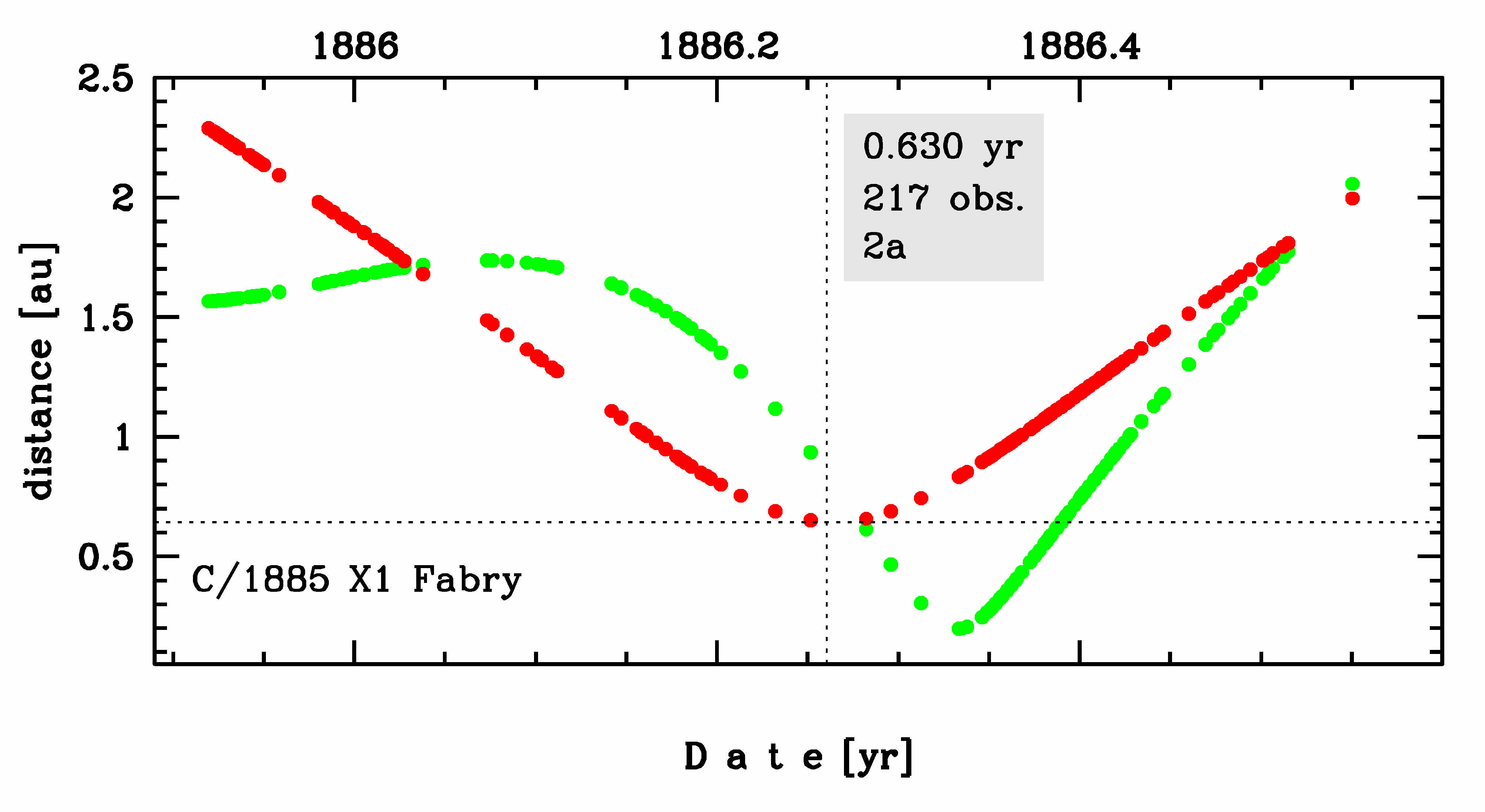C/1885 X1 Fabry
more info
C/1885 X1 was discovered on 1 December 1885 by Louis Fabry (Paris, France), about 5 months before its perihelion passage, and the comet was last seen on 30 July 1886 [Kronk, Cometography: Volume 2].
This comet made its closest approach to the Earth on 1 May 1886 (0.198 au), that is less than two weeks before perihelion passage.
Solutions given here are based on data spanning over 0.630 yr in a range of heliocentric distances from 2.29 au through perihelion (0.642 au) to 2.00 au.
This Oort spike comet suffers small planetary perturbations during its passage through the planetary system; these perturbations lead to escape the comet from the planetary zone on a hyperbolic orbit (see future barycentric orbits).
C/1885 X1 was in the original sample of 19 comets used by Oort for his hypothesis on LPCs; however, according to presented here statistics for previous perihelion passage this comet most probably is dynamically old.
See also Królikowska 2020.
This comet made its closest approach to the Earth on 1 May 1886 (0.198 au), that is less than two weeks before perihelion passage.
Solutions given here are based on data spanning over 0.630 yr in a range of heliocentric distances from 2.29 au through perihelion (0.642 au) to 2.00 au.
This Oort spike comet suffers small planetary perturbations during its passage through the planetary system; these perturbations lead to escape the comet from the planetary zone on a hyperbolic orbit (see future barycentric orbits).
C/1885 X1 was in the original sample of 19 comets used by Oort for his hypothesis on LPCs; however, according to presented here statistics for previous perihelion passage this comet most probably is dynamically old.
See also Królikowska 2020.
| solution description | ||
|---|---|---|
| number of observations | 217 | |
| data interval | 1885 12 01 – 1886 07 19 | |
| data type | perihelion within the observation arc (FULL) | |
| data arc selection | entire data set (STD) | |
| range of heliocentric distances | 2.29 au – 0.64 au (perihelion) – 2 au | |
| type of model of motion | NS - non-gravitational orbits for standard g(r) | |
| data weighting | YES | |
| number of residuals | 390 | |
| RMS [arcseconds] | 3.58 | |
| orbit quality class | 2a | |
| orbital elements (heliocentric ecliptic J2000) | ||
|---|---|---|
| Epoch | 1886 04 04 | |
| perihelion date | 1886 04 06.45438288 | ± 0.00028408 |
| perihelion distance [au] | 0.64236680 | ± 0.00000206 |
| eccentricity | 1.00027315 | ± 0.00002319 |
| argument of perihelion [°] | 126.588371 | ± 0.000120 |
| ascending node [°] | 37.963059 | ± 0.000094 |
| inclination [°] | 82.628566 | ± 0.000459 |
| reciprocal semi-major axis [10-6 au-1] | -425.22 | ± 36.10 |
| non-gravitational parameters | ||
|---|---|---|
| A1 [10-8au/day2] | 2.3366 | ± 0.2953 |
| A2 [10-8au/day2] | -0.28794 | ± 0.16058 |
| A3 [10-8au/day2] | 0 | (assumed) |
| m | -2.15 | |
| n | 5.093 | |
| k | -4.6142 | |
| r0 [au] | 2.808 | |
| α | 0.1113 | |
